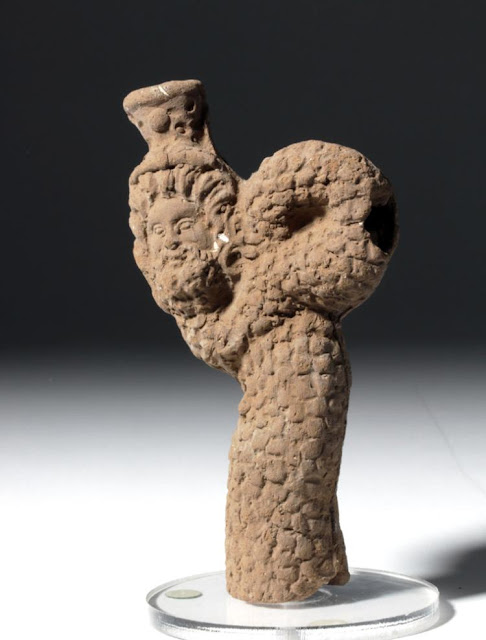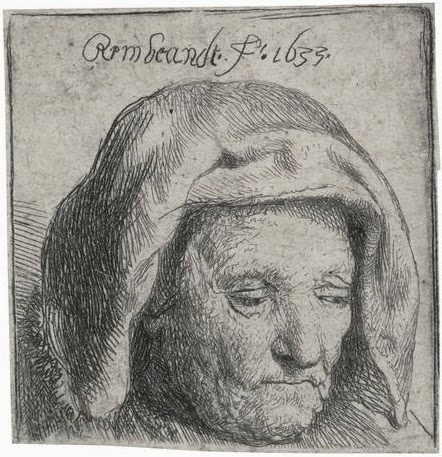Romano-Egyptian, ca. 1st century BCE to 1st century CE. Heavy gold foil formed into the likeness of a Nile crocodile. Incredibly detailed with open mouth exposing rows of deadly teeth, almond-shaped eyes and rows and rows of scaley scutes with pronounced central dorsal ridge. Size: 6.875" L (17.5 cm), 37.1 grams of 97% pure gold.
Sobek was a Crocodile god venerated at Crocodilopolis in the Faiyum, which was an important oracular centre during the Graeco-Roman Period, and, together with Haroeris (Horus the Elder), in the twin-temple at Kom Ombo where a crocodile necropolis was discovered. Seti I referred to him as Lord of Silsileh where he had a temple during the 19th dynasty. As god of the water he created the Nile from his sweat and caused plants to be lush and green, one of the traditional roles of Osiris. More
Egyptian blue composition head of a man, Roman Period
An Egyptian blue composition head of a man, Roman Period, c. 1st Century AD, perhaps a pharaoh or emperor, wearing tight-fitting headdress with uraeus, his face quite handsome, his ears outside the headdress. H: 2 ½ in (6.4 cm).
Ancient Egyptian Wooden Boatman with Articulated Arms
Ancient Egypt, Middle Kingdom, ca. 2040 to 1802 BCE. A hand-carved, three-dimensional wooden boatman, with classic Egyptian face (large, dark-outlined eyes), a cropped haircut, and a white loincloth. He is in a seated position, with long, articulated arms, which probably would have been raised to hold oars in his original placement. During the Sixth Dynasty, it became common to place wooden models of lifelike scenes in Egyptian tombs; by the Middle Kingdom, they were placed in the tomb chamber, around the coffin, although some very rich tombs had a separate chamber just for wooden models. Two ships are found in almost all tombs that have models from this time period, and those ships are, during the Middle Kingdom, staffed by boatmen like this one. This boatman was made to be a servant in the afterlife, ready to row the deceased upon the eternal Nile, as real boatmen would have done in life. Size: 2.6" W x 6.6" H (6.6 cm x 16.8 cm)
Egyptian Wooden Boatman with Articulated Arms
Ancient Egypt, Middle Kingdom, ca. 2040 to 1802 BCE. A hand-carved, three-dimensional wooden boatman, with a painted face, a cropped haircut, painted reddish skin, and a white loincloth. Size: 2.3" W x 7.8" H (5.8 cm x 19.8 cm)
Large Egyptian Pottery Astarte Figure
Egypt, New Kingdom or earlier, ca. 1543 to 1292 BCE. A large hollow pottery figure of a female goddess with a voluptuous body and a large headdress. She wears jewelry and very little clothing. Her hair is long, straight, and painted black; atop her head is a massive headdress topped by what appears to be four ostrich feathers. Although the figure is painted, it also has the look of being a mold for a bronze statue; it may have served a dual purpose. Astarte is the goddess who is also known as Ishtar in some parts of Mesopotamia. During the 18th Dynasty, she arrived in Egypt, brought by contact with Semitic people. She was worshipped in Egypt as a warrior goddess and often paired with the violent war goddess Anat. Size: 5.25" W x 18.3" H (13.3 cm x 46.5 cm)
Egyptian Deep Blue Faience Amulet of Sekhmet
Egypt, New Kingdom, 18th Dynasty, Amarna Period, ca. 1353 BCE. A small faience amulet in the shape of a bust of Sekhmet. The goddess, a fierce hunter, is depicted as a lioness wearing a traditional Egyptian crown (the uraeus has broken off). She was prayed to as a protector of pharaohs and led them in warfare. Size: 0.55" W x 0.95" H (1.4 cm x 2.4 cm)
Egyptian Faience Thoth Baboon Amulet
Egypt, Third Intermediate Period to Late Dynastic Period, ca. 1070 to 332 BCE. A highly-detailed faience amulet of the god Thoth in his baboon form. Thoth was the god of writing, accounting, and other intellectual pursuits, associated with the ibis and the baboon. 0.75" W x 1.6" H (1.9 cm x 4.1 cm)
Egyptian White Faience Ushabti
Egypt, probably Memphis, New Kingdom, Ramesside period, Dynasty XIX, ca. 1279 to 1193 BCE. Mummiform votive ushabti, white faience with transparent glaze, details in black, wearing a short wig with sidelock (wick of youth) and a small goatee, adorned with a broad usekh collar, holding agricultural implements in each hand, seed sack on the back and a column of hieroglyphic inscriptions on front naming “Rema” as the owner. Translation is "The iIluminated one, the Osiris, Sem Priest of Ptah, r m a." Size: 5.625" H (14.3 cm)
Egyptian terracotta figure of Harpokrates on horseback
A large Egyptian terracotta figure of Harpokrates on horseback, Roman, c. 1st - 2nd Century AD, dressed in a short tunic and wears a large bound wreath and a Double Crown, his left hand on the horse’s head, right hand on its flank. H: 9 in (23cm), W: 6 4/5 in (17.3cm).
Silver statuette representing Harpocrates
Greco-Roman, Dynasty Ptolemaic , 350-30 BC
Harpokrates. In late Greek mythology as developed in Ptolemaic Alexandria, Harpocrates is the god of silence, secrets and confidentiality. Harpocrates was adapted by the Greeks from the Egyptian child god Horus. To the ancient Egyptians, Horus represented the newborn Sun, rising each day at dawn. When the Greeks conquered Egypt under Alexander the Great, they transformed the Egyptian Horus into their Hellenistic god known as Harpocrates. More
Isis (on the left, holding a sistrum), Sarapis (wearing a modius), the child Harpocrates (holding a cornucopia) and Dionysos (holding the thyrsus). Marble relief, last quarter of the 2nd century CE, found at Henchir el-Attermine, Tunisia.
H. 1.92 m (6 ft. 3 ½ in.), W. 83 cm (32 ½ in.)
Louvre Museum
Nefertoum
Louvre Museum
Nefertem was, in Egyptian mythology, originally a lotus flower at the creation of the world, who had arisen from the primal waters. Nefertem represented both the first sunlight and the delightful smell of the Egyptian blue lotus flower, having arisen from the primal waters within an Egyptian blue water-lily, Nymphaea caerulea.
Nefertem the child comes from his earth father Nun's black primordial waters, and his sky mother is Nut. When he matures, he is Ra.
Nefertem was eventually seen as the son of the Creator god Ptah, and the goddesses Sekhmet and Bast were sometimes called his mother. In art, Nefertem is usually depicted as a beautiful young man having blue water-lily flowers around his head. As the son of Bastet, he also sometimes has the head of a lion or is a lion or cat reclining. The ancient Egyptians often carried small statuettes of him as good-luck charms. More
God Shu holding the sky above his head
Cairo Museum
Shu (Egyptian for "emptiness" and "he who rises up") was one of the primordial Egyptian gods, a personification of air, one of the Ennead of Heliopolis. Shu was the father of Nut and Geb and grandfather of Osiris, Isis, Set and Nephthys. His great-grandsons are Anubis and Horus. More
Images are copyright of their respective owners, assignees or others. Some Images may be subject to copyright
I do not sell art, art prints, framed posters or reproductions. Ads are shown only to compensate the hosting expenses.
If you enjoyed this post, please share with friends and family.











































